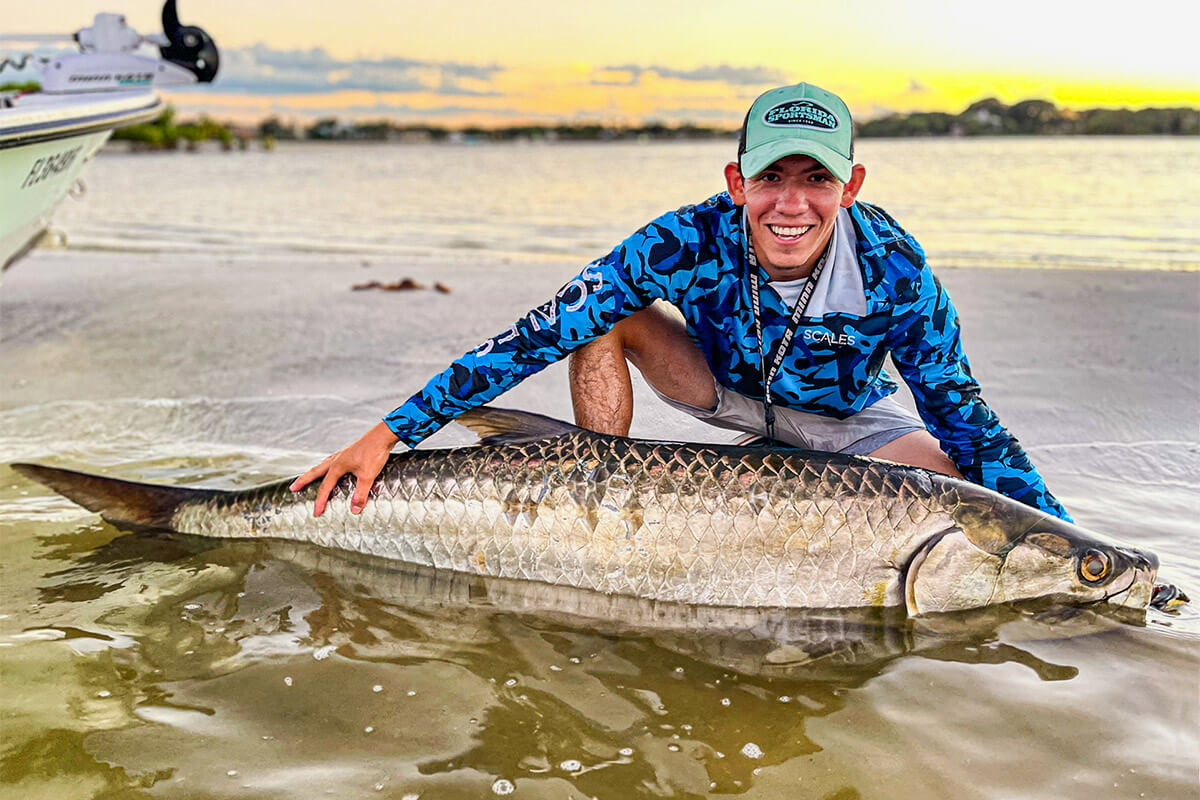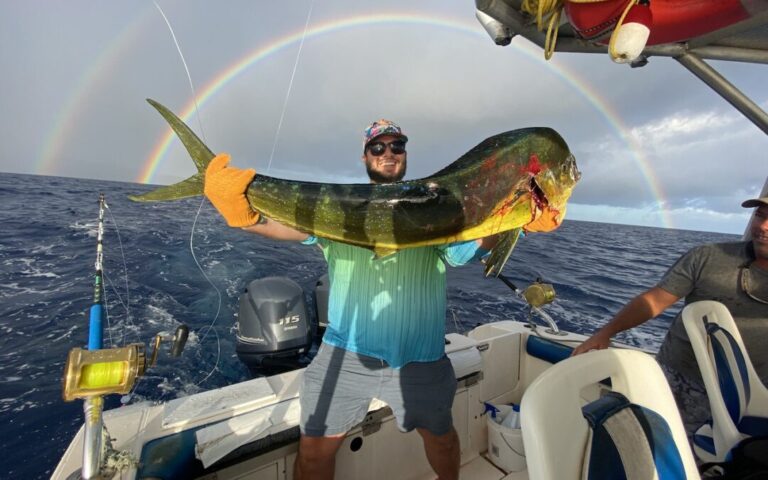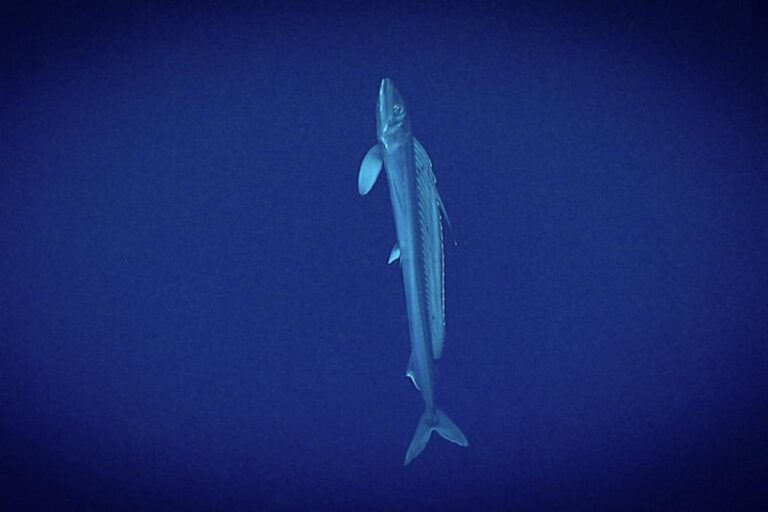To attract fish during deep sea fishing, you can use specific bait, attractants, and fishing techniques. By understanding the fish species you are targeting and their feeding habits, you can choose the right bait and attractants to entice them towards your fishing area.
Additionally, using sound-producing and visual attracting techniques can also increase your chances of attracting fish. We will explore these strategies in more detail and provide tips on how to attract fish effectively during deep sea fishing.

Credit: www.floridasportsman.com
Understanding Deep Sea Fishing
Deep sea fishing is an exciting and challenging activity that allows fishing enthusiasts to explore the depths of the ocean in search of big game fish. If you’re looking to attract fish during your deep sea fishing trips, it’s important to understand the nature of this type of fishing and the factors that can influence your success.
In this section, we’ll take a closer look at deep sea fishing, its benefits, and some popular locations where you can embark on this thrilling adventure.
Introduction To Deep Sea Fishing
Deep sea fishing, also known as offshore fishing, involves venturing far from the shoreline and casting your lines into the deep ocean waters. Unlike fishing in lakes or rivers, deep sea fishing opens up a whole new world of possibilities, where you have the opportunity to target larger and more powerful species of fish.
It requires specialized equipment, such as sturdy fishing rods and reels, along with knowledge of the marine environment and the behavior of different fish species.
Benefits Of Deep Sea Fishing
- Thrilling experience: Deep sea fishing offers an adrenaline rush like no other. The thrill of battling with powerful fish such as marlin, sailfish, or tuna is unmatched. The fight between man and fish in the open ocean is an exhilarating experience that you won’t easily forget.
- Abundance of fish: The deep sea is home to a wide variety of fish species, including some of the most sought-after game fish. From the mighty marlin to the elusive swordfish, there’s no shortage of targets for anglers looking to test their skills and catch trophy-sized fish.
- Escape from the crowd: In contrast to fishing in crowded freshwater bodies, deep sea fishing allows you to escape the hustle and bustle of the shore. Out in the wide-open ocean, you can enjoy the serenity and solitude of the marine environment, creating a peaceful and immersive experience.
- Opportunity for exploration: Deep sea fishing takes you to uncharted waters, where you can explore new fishing grounds and discover hidden hotspots. These unexplored areas often yield the best catches, providing an adventure of a lifetime for fishing enthusiasts.
Popular Locations For Deep Sea Fishing
- Florida keys: Known for its diverse marine life and abundant fishing opportunities, the florida keys offer an array of deep sea fishing charters. From key largo to key west, you can target fish such as sailfish, mahi-mahi, and grouper in the crystal-clear waters.
- Cabo san lucas, mexico: This world-renowned fishing destination attracts anglers from all over the globe. Situated at the tip of the baja california peninsula, cabo san lucas offers exceptional deep sea fishing opportunities for species like marlin, dorado, and yellowfin tuna.
- Great barrier reef, australia: With its stunning coral reefs and rich biodiversity, the great barrier reef is not only a snorkeler’s paradise but also a fantastic deep sea fishing destination. Anglers can target species like black marlin, red emperor, and spanish mackerel amidst the breathtaking beauty of this natural wonder.
- Outer banks, north carolina: The outer banks, stretching along the coast of north carolina, is a prime location for deep sea fishing. Here, you can target a variety of fish, including blue marlin, white marlin, wahoo, and tuna, while enjoying the picturesque scenery of this coastal paradise.
Deep sea fishing presents a unique opportunity to test your angling skills and experience the thrill of reeling in big game fish. Whether you’re looking for an adrenaline rush, a peaceful escape, or an exciting adventure, deep sea fishing offers it all.
So, grab your gear, choose one of these popular locations, and embark on an unforgettable fishing expedition in the deep, blue ocean.
The Role Of Bait And Lures
Choosing The Right Bait And Lures For Deep Sea Fishing
When it comes to attracting fish during deep sea fishing, choosing the right bait and lures is crucial. Here are some key points to consider:
- Research the target fish species: Different fish species are attracted to different types of bait and lures. Do your research beforehand to understand what kind of fish you are targeting and what they typically feed on.
- Consider the fishing location: The location of your deep sea fishing adventure also plays a role in bait and lure selection. Take into account the water conditions, temperature, and depth to determine the most suitable bait and lures for that particular area.
- Live bait vs. Artificial lures: Live bait, such as squid, mackerel, or shrimp, can be highly effective in attracting fish since it mimics natural prey. However, artificial lures like jigs, soft plastics, or crankbaits can also be successful if used correctly. Experiment with both options to see what works best for you.
- Match the bait to the fish: Different fish species have specific preferences when it comes to bait. Some may be more attracted to oily bait like sardines or anchovies, while others may favor crustaceans like crab or shrimp. Match your bait choice to the specific fish species you are targeting to increase your chances of success.
Types Of Bait And Lures That Attract Specific Fish Species
To successfully attract specific fish species during deep sea fishing, it’s important to know which bait and lures are most effective. Consider the following:
- Chum bait: Chumming involves dispersing small pieces of bait into the water to create a feeding frenzy. This can attract a wide range of fish species, including tuna, snapper, or mahi-mahi. Use a mixture of fish carcasses, blood, and fish oils to lure fish to your baited lines.
- Topwater lures: For exciting surface action, use topwater lures like poppers or stickbaits. These lures create enticing splashes and movements that attract fish like king mackerel, tarpon, or yellowfin tuna. Experiment with different sizes and colors to find what works best for your target species.
- Deep diving lures: If you’re looking to target fish species that dwell deeper in the water column, opt for deep diving lures. These lures are designed to dive to specific depths and can attract fish like grouper, red snapper, or amberjack. Adjust the diving depth according to the target species and the water conditions.
- Soft plastics: Soft plastic lures, such as swimbaits or grubs, are versatile and can be used for various fish species. These lures mimic the movement and appearance of natural prey, making them particularly effective for species like striped bass, flounder, or halibut. Experiment with different colors and sizes to find the most enticing option.
Tips For Effectively Using Bait And Lures In Deep Sea Fishing
When it comes to using bait and lures effectively during deep sea fishing, it’s important to keep a few tips in mind:
- Vary your presentation: Fish can be finicky, so it’s essential to vary your presentation. Change the speed, depth, or retrieve technique to trigger their interest. Sometimes a slow and steady retrieve works best, while other times erratic movements can entice bites.
- Observe and adapt: Pay attention to what the fish are naturally feeding on in the area. Look for signs of activity such as diving birds or jumping fish. Adjust your bait and lure selection accordingly to match the natural prey and increase your chances of attracting fish.
- Experiment with scents: Adding scent to your bait or lures can significantly enhance their effectiveness. Use fish attractants or natural scents that mimic the smell of their preferred prey. This can help entice fish to strike and hold onto your bait for longer.
- Keep a clean fishing environment: Make sure to clean any fish slime or scent off your hands before handling bait or lures. Fish can detect foreign odors easily, so maintaining a clean and odor-free fishing environment will increase your chances of attracting fish.
Remember, successful deep sea fishing requires patience, observation, and experimentation. By choosing the right bait and lures, specific to your target species, and utilizing effective techniques, you’ll greatly improve your chances of attracting fish during your deep sea fishing adventures.
Techniques For Attracting Fish
Deep sea fishing can be an exhilarating experience, but to ensure a successful day on the water, it’s important to know how to attract fish. By understanding fish behavior and migration patterns, utilizing chumming techniques, employing drift fishing methods, and utilizing electronic fish finders and radar, you can increase your chances of a bountiful catch.
In this section, we’ll explore these techniques in detail.
Understanding Fish Behavior And Migration Patterns
- Fish are influenced by factors such as temperature, currents, and food availability when deciding where to migrate.
- Understanding fish behavior and migration patterns can help locate the best areas for deep sea fishing.
- Research the target species to determine their preferred habitats, spawning grounds, and feeding times.
- Fish tend to follow the baitfish, so locating large schools of baitfish can indicate a promising fishing spot.
- Pay attention to the tides and moon phases, as these can also affect fish activity and feeding patterns.
Using Chumming Techniques To Attract Fish
- Chumming involves dispersing small amounts of fish parts, bait, or other enticing substances into the water to attract fish.
- Chum can be created using fish parts, fish oil, or even commercially available products.
- The smell and oils from the chum will attract fish from a distance, increasing your chances of a bite.
- Use a chum bag or a mesh bag to hold the chum and hang it off the side of the boat to release a steady stream into the water.
- Remember to consult local regulations regarding chumming, as it may be restricted in certain areas.
Drift Fishing Methods To Maximize Catch Rates
- Drift fishing involves drifting with the current while presenting baits or lures to fish.
- This technique allows you to cover a larger area and present your bait in a natural manner.
- Use a variety of bait or lures to target different species and increase your chances of attracting fish.
- Experiment with different depths and speeds to find the most productive combination.
- Monitor your drift closely and be ready to react quickly when a fish strikes.
Tips For Using Electronic Fish Finders And Radar To Locate Fish
- Electronic fish finders and radar can be invaluable tools for locating fish in deep waters.
- Use fish finders to identify submerged structures, such as reefs or drop-offs, where fish may be congregating.
- Look for fish arches, which indicate the presence of fish in the water column.
- Adjust the sensitivity and range settings on your fish finder to maximize its effectiveness.
- Radar can help locate birds or schools of fish near the surface, indicating the presence of larger predatory fish below.
By understanding fish behavior, utilizing chumming techniques, employing drift fishing methods, and utilizing electronic fish finders and radar, you can significantly increase your chances of attracting fish during your deep sea fishing adventures. These techniques, combined with a bit of patience and skill, will help make your fishing trip a memorable and successful one.
So grab your gear, hop on the boat, and get ready to reel in the big ones!
Fishing Tips For Specific Fish Species
Deep sea fishing is an exhilarating adventure that offers the opportunity to catch a wide variety of fish species. Whether you’re targeting tuna, marlin, mahi-mahi, or swordfish, understanding the unique strategies and techniques for attracting and catching each species can greatly enhance your chances of a successful fishing trip.
In this section, we will explore some tips specifically tailored to attracting and hooking these four popular deep sea fish species.
Tips For Attracting And Catching Tuna
Tuna are known for their powerful strength and lightning-fast swimming speed, making them a thrilling challenge for any angler. Here are some key techniques to attract and catch tuna:
- Use chum: Creating a chum slick by dispersing a mixture of ground fish and fish oil will attract tuna to your fishing area.
- Opt for live bait: Tuna are highly responsive to live bait, such as anchovies, mackerels, or sardines. Attach a live baitfish to your hook and maintain a natural presentation.
- Utilize trolling lures: Trolling with artificial lures resembling small fish or squid can entice tuna to strike. Vary the speed and depth of your trolling to find what works best.
Strategies For Attracting And Landing Marlin
Marlin are revered among deep sea anglers for their sheer power and acrobatic displays. To attract and land these majestic creatures, keep the following strategies in mind:
- Deploy large bait: Marlin prefer larger bait fish, such as skipjack or bonito. Attach a lively baitfish to your hook, enticing the marlin with its size and movement.
- Use teaser baits: Teaser baits, rigged with lures or flashy skirts, can attract the attention of marlin. Position them in front of your main bait to create excitement and provoke a strike.
- Patience and persistence: Marlin can be elusive, so be prepared for extended periods of waiting. Remain patient and maintain focus, as landing a marlin requires dedication and skill.
Techniques For Attracting And Hooking Mahi-Mahi
Mahi-mahi, also known as dolphin fish or dorado, are renowned for their vibrant colors and energetic fights. Enhance your chances of attracting and hooking mahi-mahi with these techniques:
- Locate floating debris: Mahi-mahi often gather around floating objects, such as logs or seaweed. Keep an eye out for such debris and fish around them for increased chances of a successful catch.
- Use colorful lures: Mahi-mahi are attracted to vibrant colors, so opt for lures with bright hues or reflective surfaces. This will grab their attention and entice them to strike.
- Employ the “run and gun” method: When you spot a group of mahi-mahi, quickly approach them with your boat and cast lures or bait in their vicinity. This active approach can yield great results.
Tips For Attracting And Catching Swordfish
Swordfish are prized for their size and fighting abilities, making them a challenging species to target. Consider the following tips for attracting and catching swordfish:
- Nighttime fishing: Swordfish often rise to shallower depths at night to feed. Use specialized deep-sea rigs and lights to attract swordfish during the darkness.
- Deep-drop baits: Swordfish inhabit deep waters, so utilize heavy-duty equipment and deep-drop baits to reach their preferred depths. Squid or mackerel are common bait choices.
- Provide ample time: Swordfish are known for their patience, and so should you be. Allow the bait to soak at deep depths for an extended period before attempting a retrieve.
Now armed with these valuable tips and techniques for attracting specific fish species, make sure to incorporate them into your next deep sea fishing expedition. Remember, understanding the behavior and preferences of your target fish will significantly increase your chances of a memorable and successful catch.
Safety Considerations For Deep Sea Fishing
Understanding Safety Equipment Required For Deep Sea Fishing
When embarking on a deep sea fishing trip, it’s crucial to prioritize safety. Here are the key points to consider regarding the safety equipment required for deep sea fishing:
- Life jackets: Make sure everyone on board has a properly fitted life jacket. It should be worn at all times, especially when the waters are rough or during emergency situations.
- First aid kit: Have a well-stocked first aid kit on board, including bandages, antiseptic solutions, and any necessary medications.
- Communication devices: Carry a fully charged cellphone, a vhf radio, or an emergency beacon. These devices can be essential for contacting help in case of an emergency.
- Flares and signals: Keep a supply of flares, smoke signals, or any other signaling devices approved for maritime use. These can be crucial for attracting attention in an emergency situation.
- Safety raft: A properly maintained and readily available safety raft is essential for evacuation in case the boat becomes compromised.
- Fire extinguisher: Keep a fire extinguisher on board to quickly respond to any onboard fires that may occur.
Tips For Staying Safe On The Water During Deep Sea Fishing Trips
Here are some useful tips to ensure you stay safe while enjoying your deep sea fishing adventure:
- Wear appropriate clothing: Dress for the weather conditions and wear non-slip shoes to prevent accidents on a wet deck.
- Stay hydrated: Bring enough water to stay hydrated throughout the trip, especially under the sun. Dehydration can lead to fatigue and an increased risk of accidents.
- Be mindful of the sun: Apply sunscreen generously and wear a hat and sunglasses to protect yourself from harmful uv rays.
- Follow instructions: Listen carefully to the captain or crew’s safety instructions, such as how to operate safety equipment and proper boat behavior.
- Be aware of your surroundings: Pay attention to other boats, objects in the water, and potential hazards. Maintain a safe distance from other vessels.
- Keep balance: When moving around the boat, always maintain three points of contact to avoid slipping and falling overboard.
- Avoid overindulging: While it can be tempting to enjoy alcoholic beverages during your deep sea fishing trip, excessive alcohol consumption can impair judgment and increase the risk of accidents.
- Inform others: Before heading out, let someone reliable on land know your travel plans, including your estimated return time.
Importance Of Checking Weather Conditions And Tides
Checking weather conditions and tides is crucial for a safe deep sea fishing experience. Here’s why:
- Weather conditions: Unfavorable weather, such as strong winds, storms, or fog, can make the waters dangerous and increase the risk of accidents. It’s important to stay updated on weather forecasts and avoid venturing out in poor conditions.
- Tides: Understanding the tides is essential for choosing the right fishing spots. Certain species of fish are more active during specific tidal stages. Planning your trip around favorable tides can greatly increase your chances of a successful fishing expedition.
- Safety: Sudden changes in weather or tides can put you at risk. By monitoring these factors, you can avoid potentially dangerous situations and ensure a safer fishing experience.
Remember, deep sea fishing can be an exciting adventure, but safety should always be the top priority. By understanding the necessary safety equipment, following the provided tips, and staying informed about weather conditions and tides, you can enjoy a memorable and secure journey on the open waters.
Conclusion
Mastering the art of attracting fish during deep sea fishing is essential for a successful fishing expedition. By following the tips and techniques discussed in this blog post, you can significantly increase your chances of attracting and catching fish. Remember to choose the right fishing spot, use effective bait and lures, vary your fishing techniques, and adapt to the changing conditions.
Additionally, maintaining a calm and patient mindset, as well as being aware of local regulations, will contribute to a fulfilling and sustainable fishing experience. So, grab your fishing gear and get ready to embark on an exciting and rewarding deep sea fishing adventure.
Happy fishing!






